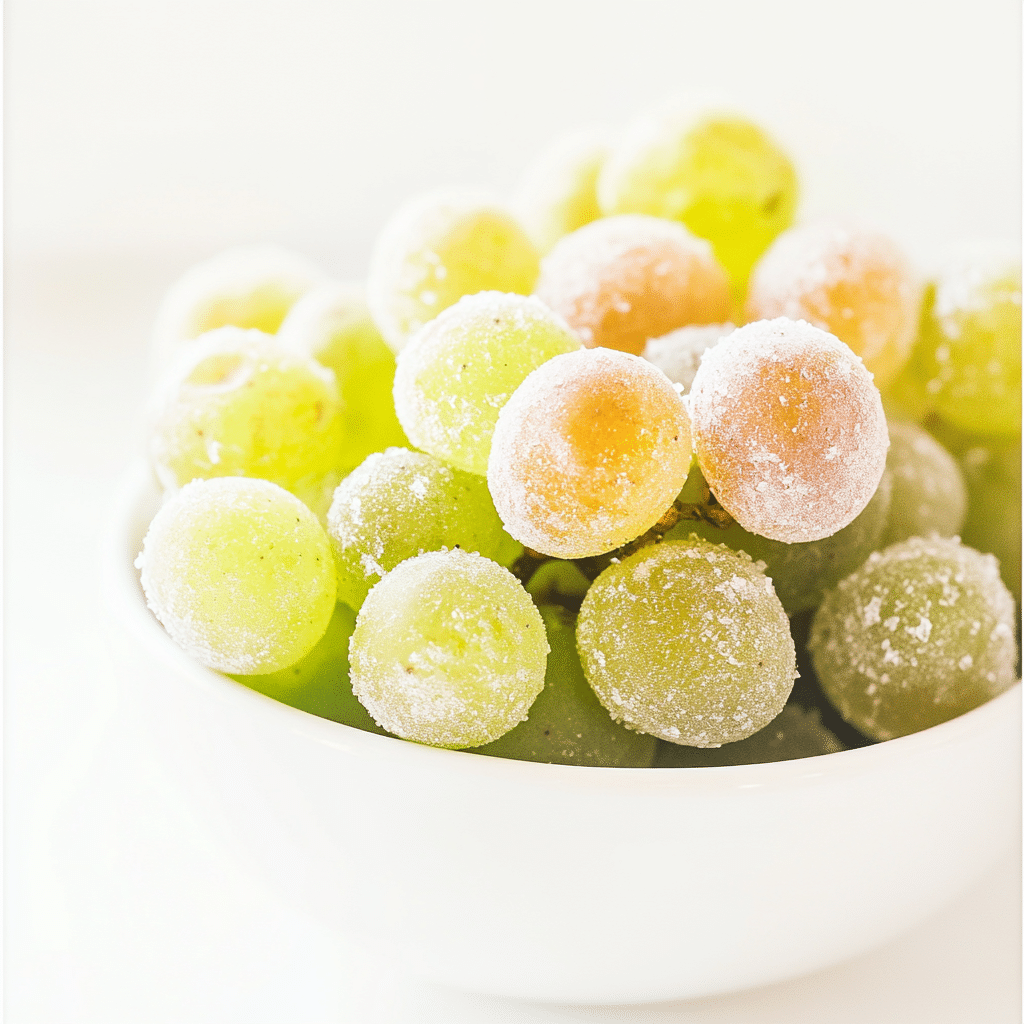Champagne grapes are tiny, delicate clusters of sweet, seedless grapes often enjoyed as a fresh snack or used as a garnish. Despite their name, they are not used to make champagne; instead, they’re celebrated for their rich flavor, unique appearance, and versatility. These grapes are also known as “Corinth grapes” and are perfect for adding elegance to a dish or a charcuterie board.
Why You’ll Love This Ingredient
- Naturally Sweet: Their small size packs a concentrated burst of natural sweetness.
- Aesthetic Appeal: Their delicate, jewel-like appearance adds sophistication to any plate.
- Versatile Usage: Delicious fresh, dried as currants, or incorporated into recipes.
- Healthy Snack: Packed with antioxidants, vitamins, and fiber, they’re a guilt-free treat.
Ingredients
(Tip: You’ll find the full list of ingredients and measurements in the recipe card below.)
For recipes or serving suggestions featuring champagne grapes, you may need:
- Fresh champagne grapes
- Cheese (e.g., brie, goat cheese)
- Nuts (almonds, walnuts)
- Crackers or bread
- Honey or balsamic glaze (optional, for drizzling)
Directions
While champagne grapes are often eaten fresh, here are a few simple ways to enjoy them:
- Snack Platter: Arrange champagne grapes alongside cheese, crackers, and nuts for a quick and elegant snack.
- Dessert Garnish: Use as a topping for cakes, tarts, or panna cotta.
- Salad Addition: Toss with greens, walnuts, and goat cheese for a sweet and savory salad.
- Roasted Grapes: Roast with olive oil and balsamic vinegar for a caramelized topping on bruschetta or meat dishes.
- Freeze for a Treat: Freeze champagne grapes for a refreshing and healthy alternative to candy.
Servings and Timing
- Servings: One pound of champagne grapes serves about 4-6 people as a snack or garnish.
- Prep Time: 5 minutes
- Total Time: 5 minutes
Variations
- Currant Substitute: Use dried champagne grapes (currants) in baking, such as scones, muffins, or bread.
- Sparkling Garnish: Serve clusters with a glass of champagne for a luxurious pairing.
- Charcuterie Board: Pair with cured meats, honeycomb, and artisanal crackers for a standout charcuterie display.
- Infused Water: Add to sparkling water with mint for a refreshing drink.
- Jam Making: Simmer with sugar and lemon juice for a simple homemade grape jam.
Storage/Reheating
- Storage: Keep fresh champagne grapes in their original container or a paper towel-lined bowl in the refrigerator for up to one week.
- Freezing: Freeze in a single layer on a baking sheet, then transfer to a freezer-safe container for up to 3 months.
FAQs
Are champagne grapes used to make champagne?
No, they are named for their resemblance to sparkling champagne bubbles but are not used in champagne production.
What is the best way to wash champagne grapes?
Rinse gently under cold water and pat dry with a paper towel. Their delicate stems can break easily, so handle with care.
Can I substitute champagne grapes for other grapes in recipes?
Yes, but their small size and intense sweetness may require adjustments in recipes.
Are champagne grapes seedless?
Yes, they are naturally seedless, making them ideal for snacking and baking.
Can I eat the stems?
While the stems are edible, they’re typically not consumed due to their fibrous texture.
How do champagne grapes differ from regular grapes?
Champagne grapes are much smaller, sweeter, and have a thinner skin compared to standard table grapes.
Are champagne grapes healthy?
Yes, they are rich in antioxidants, vitamins C and K, and fiber, making them a nutritious snack.
Can I use them in savory dishes?
Absolutely! Their sweetness pairs beautifully with cheeses, meats, and salads.
Are dried champagne grapes the same as currants?
Yes, dried champagne grapes are often labeled as currants and are popular in baking.
Where can I buy champagne grapes?
They are available at specialty grocery stores, farmers’ markets, and some larger supermarkets, especially during their peak season in summer.
Conclusion
Champagne grapes are a delightful addition to any table, whether enjoyed fresh, dried, or incorporated into recipes. Their sweetness, versatility, and elegant appearance make them a standout ingredient that elevates both casual and gourmet dishes. Add a touch of sophistication to your meals with these tiny, flavor-packed gems!
Print
Champagne Grapes
Description
Champagne grapes are tiny, delicate clusters of sweet, seedless grapes often enjoyed as a fresh snack or used as a garnish. Despite their name, they are not used to make champagne; instead, they’re celebrated for their rich flavor, unique appearance, and versatility. These grapes are also known as “Corinth grapes” and are perfect for adding elegance to a dish or a charcuterie board.
Ingredients
(Tip: You’ll find the full list of ingredients and measurements in the recipe card below.)
For recipes or serving suggestions featuring champagne grapes, you may need:
- Fresh champagne grapes
- Cheese (e.g., brie, goat cheese)
- Nuts (almonds, walnuts)
- Crackers or bread
- Honey or balsamic glaze (optional, for drizzling)

